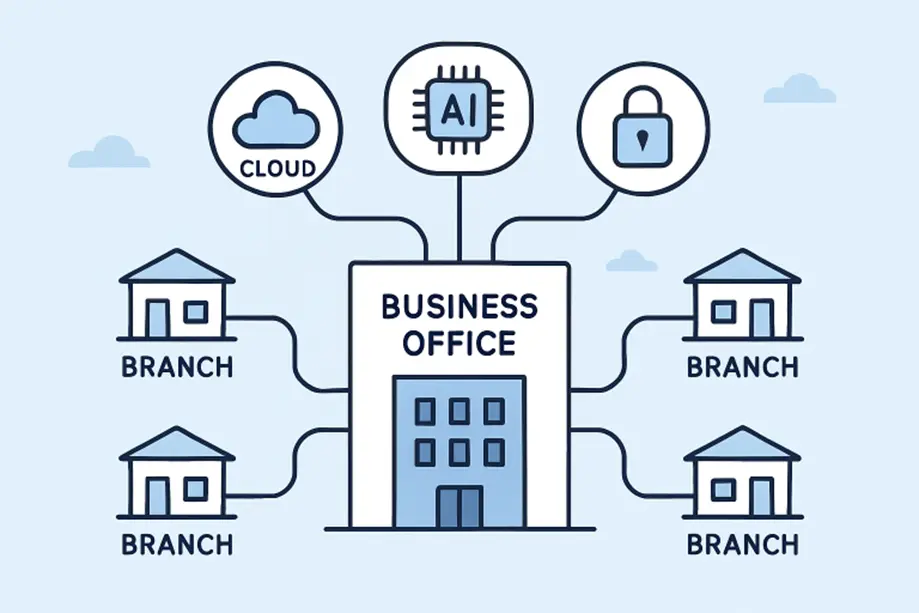How SD-WAN Is Streamlining Modern Business Connectivity
Introduction
Modern businesses are rapidly evolving to meet increasing digital demands and the need for seamless, secure, and agile connectivity. Traditional network architectures can no longer handle the complexities of today’s traffic and cloud-driven environments. As a result, SD-WAN has emerged as a leading technology, reshaping business networks by increasing flexibility, improving uptime, and optimizing bandwidth allocation.
Companies deploying SD-WAN benefit from a unified approach to connecting branch offices, remote workers, and headquarters. By shifting away from the rigidity of MPLS and other legacy WAN technologies, SD-WAN enables dynamic traffic management, cost efficiency, and enhanced performance for critical applications and cloud services. These features make it especially valuable for organizations seeking to future-proof their networks.
SD-WAN offers the agility needed for cloud adoption and digital transformation and simplifies ongoing management. These unique capabilities are driving rapid adoption among businesses large and small. The shift to this adaptive, software-defined model lays the groundwork for increased productivity and resilience across industries.
Demand for integrated, cloud-first networking solutions continues to grow. Enterprises must balance the need for secure, scalable connectivity with the imperative to control costs and optimize user experiences. Exploring SD-WAN’s functionalities reveals why it’s become foundational in the modern IT toolkit.
Understanding SD-WAN
SD-WAN, or Software-Defined Wide Area Networking, separates network management from the underlying hardware. Traditional WANs depend on fixed, high-cost circuits like MPLS to connect different business locations. In contrast, SD-WAN allows organizations to simultaneously use multiple connection types—such as broadband, MPLS, and LTE. A centralized control plane empowers IT teams to set network policies, monitor performance, and optimize traffic flows from a single console.
The architecture behind SD-WAN is designed to intelligently steer traffic based on application priority, current network health, and real-time conditions. Routes can be adjusted on the fly, ensuring that critical business applications always receive optimal performance and reliability. This capability is essential to hybrid and multi-cloud environments, where latency and availability can impact productivity.
According to Cisco, SD-WAN enables organizations to build a scalable, resilient, and SASE-ready network, delivering seamless user experiences and optimizing application performance.
Key Benefits of SD-WAN
- Cost Efficiency: Leveraging affordable Internet connections alongside traditional circuits, SD-WAN sharply reduces WAN expenses by minimizing reliance on exclusive MPLS services.
- Improved Performance: Application-aware routing and dynamic path selection prioritize mission-critical traffic over less critical data, ensuring consistent user experiences across the organization.
- Scalability: Centralized management platforms make adding new sites, configuring policies, and monitoring health easy without requiring extensive manual intervention or hardware upgrades.
In addition to lower operating costs, SD-WAN enables a faster response to business changes, supporting mergers, acquisitions, or rapid expansion into new markets.
SD-WAN and Cloud Integration
Today’s enterprises depend heavily on cloud applications, from productivity suites to CRM and ERP platforms. SD-WAN provides secure, low-latency connections to public, private, and hybrid clouds. Supporting direct cloud on-ramps bypasses traditional backhaul paths, reducing lag and improving end-user responsiveness.
Seamless integration with leading cloud service providers means SD-WAN can deliver policy-based connectivity while maintaining compliance, visibility, and control. This multitenant support for organizations running multi-cloud strategies is crucial in maintaining a competitive edge and user satisfaction.
GTT notes that SD-WAN architecture addresses security, application performance, and other complexities, making it a simplified solution for enterprises to connect to cloud services.
Enhancing Security with SD-WAN
Security, an ever-present concern in the digital age, is built into many leading SD-WAN solutions. These platforms often feature AI-powered security stacks, supporting advanced measures such as Zero Trust Network Access (ZTNA), Secure Web Gateways (SWG), and end-to-end encryption. Every data packet can be scrutinized and protected, minimizing risk across distributed corporate environments.
Integration with identity management systems, threat intelligence feeds, and real-time monitoring capabilities further extends SD-WAN’s security proposition. These dynamic controls defend against attackers’ lateral movement, reduce the attack surface, and simplify compliance with data protection regulations.
AI-Driven SD-WAN Management
Artificial Intelligence is revolutionizing SD-WAN management. AI-powered engines help network administrators automate repetitive tasks, rapidly diagnose issues, and optimize routing based on current conditions. These tools analyze real-time data streams, learning typical usage patterns and preemptively addressing potential performance bottlenecks or threats.
Some advanced SD-WAN tools use AI to automate policy changes, respond to evolving traffic trends, and even trigger security incident responses. The result is a more resilient, efficient network, freeing IT teams to focus on strategic projects while assuring consistent uptime and superior user experiences.
Real-World Applications
Retail, finance, healthcare, and manufacturing industries are leveraging SD-WAN to transform business outcomes. For example, retailers use SD-WAN to connect thousands of branches securely, streamline PCI compliance, and enhance in-store digital experiences. Financial institutions integrate SD-WAN with Secure Access Service Edge (SASE) frameworks to enable secure, high-speed trading from any location.
SD-WAN and SASE
The unification of networking and security in SASE models is accelerating SD-WAN adoption. Combining ZTNA, FWaaS (Firewall as a Service), and SWG in a cloud-native package, SASE empowers secure, policy-driven connectivity for office and remote workers, all managed through a single pane of glass.
Conclusion
SD-WAN has emerged as a game-changing technology for businesses striving to achieve faster, smarter, and more reliable connectivity across distributed environments. By replacing rigid, hardware-bound networks with software-defined intelligence, SD-WAN enhances agility, optimizes bandwidth, and reduces operational costs. Its seamless integration of cloud platforms and AI-driven analytics empowers organizations to manage traffic dynamically, improve application performance, and strengthen cybersecurity measures. With centralized control and real-time visibility, IT teams can ensure consistent, secure user experiences across locations. As digital transformation accelerates, adopting SD-WAN becomes essential for sustaining growth, efficiency, and resilience—enabling enterprises to stay competitive and adaptable in a cloud-connected, data-driven world where flexibility and security define long-term success.

